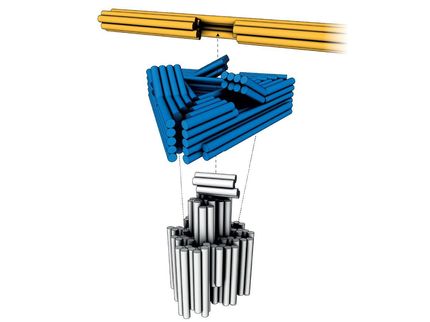Chemists use DNA to build the world's tiniest thermometer
Researchers at University of Montreal have created a programmable DNA thermometer that is 20,000x smaller than a human hair. This scientific advance reported this week in the journal Nano Letters may significantly aid our understanding of natural and human designed nanotechnologies by enabling to measure temperature at the nanoscale.
Over 60 years ago, researchers discovered that the DNA molecules that encode our genetic information can unfold when heated. "In recent years, biochemists also discovered that biomolecules such as proteins or RNA (a molecule similar to DNA) are employed as nanothermometers in living organisms and report temperature variation by folding or unfolding," says senior author Prof. Alexis Vallée-Bélisle. "Inspired by those natural nanothermometers, which are typically 20,000x smaller than a human hair, we have created various DNA structures that can fold and unfold at specifically defined temperatures."
One of the main advantages of using DNA to engineer molecular thermometers is that DNA chemistry is relatively simple and programmable. "DNA is made from four different monomer molecules called nucleotides: nucleotide A binds weakly to nucleotide T, whereas nucleotide C binds strongly to nucleotide G," explains David Gareau, first author of the study. "Using these simple design rules we are able to create DNA structures that fold and unfold at a specifically desired temperature." "By adding optical reporters to these DNA structures, we can therefore create 5 nm-wide thermometers that produce an easily detectable signal as a function of temperature," adds Arnaud Desrosiers, co-author of this study.
These nanoscale thermometers open many exciting avenues in the emerging field of nanotechnology, and may even help us to better understand molecular biology. "There are still many unanswered questions in biology," adds Prof. Vallée-Bélisle, "For example, we know that the temperature inside the human body is maintained at 37° C, but we have no idea whether there is a large temperature variation at the nanoscale inside each individual cell." One question currently under investigation by the research team is to determine whether nanomachines and nanomotors developed by nature over millions years of evolution also overheat when functioning at high rate. "In the near future, we also envision that these DNA-based nanothermometers may be implement in electronic-based devices in order to monitor local temperature variation at the nanoscale," concludes Prof. Vallée-Bélisle.
Original publication
Other news from the department science

Get the analytics and lab tech industry in your inbox
By submitting this form you agree that LUMITOS AG will send you the newsletter(s) selected above by email. Your data will not be passed on to third parties. Your data will be stored and processed in accordance with our data protection regulations. LUMITOS may contact you by email for the purpose of advertising or market and opinion surveys. You can revoke your consent at any time without giving reasons to LUMITOS AG, Ernst-Augustin-Str. 2, 12489 Berlin, Germany or by e-mail at revoke@lumitos.com with effect for the future. In addition, each email contains a link to unsubscribe from the corresponding newsletter.





















































